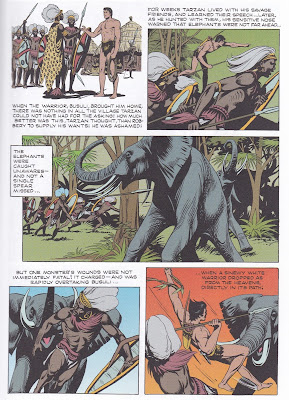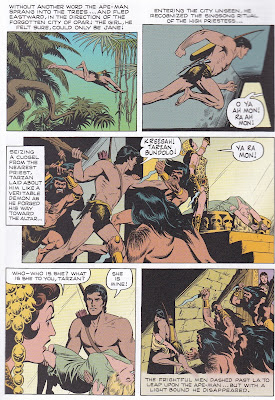Edgar Rice Burroughs' Tarzan of the Apes #156 (February 1966)
Gaylord DuBois-Russ Manning
Tarzan #s 219, 220, 221, 222, and 223 (April, June-September 1974)
Joe Kubert
Doug: A long time ago I got the crazy idea to showcase one Conan story, "The Tower of the Elephant", but
drawn by two Bronze Age masters: Barry Windsor-Smith (inked by Sal Buscema) and John Buscema (inked by Alfredo Alcala). People got a kick out it then, and lo and behold if the crazy idea didn't hit me again. Today we'll also look at the work of two masters, this time Russ Manning and Joe Kubert, both men inking their own pencils. Manning and his scribe, Gaylord DuBois, adapted the ERB tale "The Return of Tarzan" in a single issue; Joe Kubert took five issues (!) to tell his version. Today we'll check out a
100-Word Review of the basic plot, so those not in the know can consider themselves... in the know. Then we'll look at some key scenes as told by these two wonderful artists. Enjoy!
Thrown overboard from a steamer, Tarzan swam toward the
African coast. As fate played out, he took shore a short distance from the
cabin where he was born. Searching for arms, he encountered a Black warrior and
saved the man from Numa, the lion. Welcomed to the tribe, Tarzan soon became
their chieftain. Tarzan led his troops in search of a lost city – Opar! There
he found danger in the form of the 50 Frightful Men and La, their high
priestess. He also found gold beyond imagination, which he later plundered for his
own benefit. And he won Jane’s heart…
Doug: I have to say that 100 words wasn't really enough to do the plot justice, but darned if that ellipsis didn't land after the 100th word - nailed it! Joe Kubert spent 2 1/2 issues to get to the spot where DuBois and Manning began their adaptation. Kubert gave quite a bit of backstory in regard to Tarzan's "rejection" by Jane Porter in her favor toward William Cecil Clayton, Tarzan's cousin and Lord Greystoke. Tarzan's friend, Lt. D'Arnot had gotten Tarzan a position as an international spy (just suspend your disbelief, OK?), and our hero encountered a certain Nikoklas Rokoff. Rokoff was a dangerous Russian criminal intent on all manner of do-badding. It was Rokoff and his assistant who assaulted Tarzan unawares on the ship's deck. But before that had happened, Tarzan had by chance met Hazel Strong, the best friend of Jane Porter. What a coincidence - to be sailing near the southern tip of Africa with an American woman from Baltimore who just happens to be friendly with the forbidden fruit of your dreams. Man... And then when she tells that Jane doesn't want to marry Lord Greystoke but some Tarzan fellow she'd met in the jungle... Of course, being chucked into the sea sort of put all that on the back burner.
Doug: I'm going to choose several examples of Manning and Kubert telling the same parts of this story. I think you'll see how illustrative Manning's work was, and how raw Kubert's was. Manning's work sort of feels like the Ron Ely
Tarzan television show; Kubert's feels more like the Christopher Lambert film,
Greystoke: The Legend of Tarzan, Lord of the Apes. I'd also say that Manning's women evoke the glamour girls of 1940's Hollywood. When necessary, I'll tell you what's going on, or where the two men parted company in just how they told this story. You can imagine that with Manning using 24 pages and Kubert exercising his prowess over 90 pages there were some differences. However, what really interested me were some details that I felt were important to the story that Kubert skipped altogether, and how each penciler put certain events in a different order. Doing this post makes me want to reread the Burroughs novel!
Scans today are coming your way from the
Tarzan Comics Library, Volume One (Dark Horse Comics 1999) and
Tarzan: The Joe Kubert Years, Volume Two (Dark Horse Comics, 2006).
Manning gets after it right away; it took Kubert almost three full issues to get to this scene below!
Interesting how the creators handle this scene with the lion. In the Manning issue Tarzan loses his balance and needs to be saved by the African; Kubert has the ape-man ever dominant. We can infer that Tarzan intended to kill the African for his weapons, but Kubert's jungle lord thinks to himself that he could never kill to steal -- Kubert's scene shows a more skillful and noble Tarzan.
Here, Tarzan -- apparently no environmentalist, agrees to go on an elephant hunt with his new friends. Kubert presents the scene as a rogue elephant has endangered the compound and must be dealt with.
In both stories, Tarzan learns of a lost city filled with gold. A member of the Waziri tells him the rumors, so Tarzan selects 50 strong warriors to accompany him on his search. However, stereotypical "savage" superstitions get in the way of the mission.
I'm always digging the 50 Frightful Men -- Burroughs painted such a picture in my mind that artists' renditions always fall a little short in comparison to the way I'd originally "seen" these brutes... sort of like the Seven Dwarfs as craggy cave men.
La. I think Manning got it "right" moreso than did Kubert. Of course, many artists have tried their hand at depicting the high priestess --
click here. In the scene below, Tarzan protects La from a mad suitor.
The great escape. This is another scene that Burroughs did a great job of painting for me. It's interesting that Manning has Tarzan find the gold right away; in Kubert's version Tarzan leaves to meet up with the Waziri and then comes back and discovers the gold later.
Of course, what would a Tarzan epic be if there wasn't a scene where Jane Porter fell into mortal danger? Here she is captured by the 50 Frightful Men and taken to Opar. Again, Manning and Kubert tell this scene a bit differently, and spaced differently in the order of events.
William Cecil Clayton, deceiver of many, meets his ending -- and title of Lord Greystoke:
Tarzan weds his lady. Jane nee Porter becomes Mrs. John Clayton, Lady Greystoke.
I hope you enjoyed our joint tour of these two tellings of
The Return of Tarzan. I found it fascinating as I read each story how the creators chose to tell certain parts, to take artistic liberties with Burroughs' original writing, and even to reorganize major plot points. I hope you had a good time looking at the samples I've provided today.
Doug: I actually saw this on Thursday (3/24/16), but didn't want to hijack Martinex's $1 Challenge. Those of you who have found pleasure in my various reveals of the IDW Artist Editions may recall that I've pre-ordered the Jack Kirby's Thor book that is supposed to ship in May. Here's
a link to a site offering glimpses of the book -- spectacular stuff!





















































































